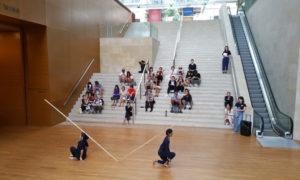Singapore: Spring 2019 - Vancouver Ballet Society
- Home
- City Reports 2015 - 2019
- Singapore: Spring 2019

By Malcolm Tay
In the course of programming shows and commissioning new creations, the annual da:ns festival has helped facilitate unexpected partnerships. While Bangladeshi-British dancer-choreographer Akram Khan was performing at the festival in 2015, his company producer Farooq Chaudhry was invited to watch SoftMachine, a series of documentary performances featuring four Asian dance artists. Among them was Rianto (he goes by one name), whose background in Javanese court and folk traditions inflects his contemporary work. Chaudhry was so impressed with the Indonesian native that he asked a gobsmacked Rianto to replace Khan in the company’s touring production of Until the Lions.
Presented at the Esplanade Theatre during the da:ns festival in October, Until the Lions is based on a tale from French-Indian poet Karthika Naïr’s female-centric retelling of the Mahabharata. Rianto played the prince, Bhishma, who kidnaps the princess, Amba (Ching-Ying Chien), and ruins her life. Swearing revenge, Amba kills herself and is reborn as Shikhandi (Joy Alpuerto Ritter), who becomes a man by swapping genders with a forest deity and slays Bhishma in battle. While Khan’s Bhishma was a stolid warrior, Rianto brought an ambiguity to the role that added a certain tenderness to his clashes with Chien.
A similar ambiguity was amplified in the premiere of his evening-length Medium, co-commissioned by the festival. At the Esplanade Theatre Studio, the focus fell on the shifting physicality of Rianto’s lone body, accompanied by the spare percussions and vocals of Indonesian musician Cahwati. His cryptic whispers in darkness yielded to other sounds and gestures evoking feathered and feline creatures. The shapes and dynamics of his solo varied between hard and soft, reflecting his training in lengger, a folk dance in Central Java often performed by men in drag. But, here, Rianto stood for something not quite human or animal, male or female, as he moved compellingly between the borders of form and gender.
In November, the opening of Minimalism: Space. Light. Object. brought the efforts of some postmodern-dance pioneers to the public’s attention. Featuring a few works by Simone Forti and Yvonne Rainer, this blockbuster exhibition — jointly organized by the National Gallery Singapore and the ArtScience Museum — included screenings of Breath Made Visible, a 2009 biographical film about Anna Halprin, and In the Steps of Trisha Brown, a 2016 documentary about Paris Opera Ballet dancers learning Brown’s Glacial Decoy (1979). The pared-down conceptualism of Brown’s early oeuvre, in particular, was highlighted in a lecture by Leah Morrison, an alumna of Brown’s eponymous troupe, and in two weekends of free performances.
Morrison restaged three Brown classics for two groups of 12, comprising local dancers and dance majors from LASALLE College of the Arts. Wearing navy-blue pullovers and pants, they performed at two different sites in the National Gallery Singapore while visitors stopped to watch. In Leaning Duets I (1970), a couple walked slowly while grasping each other by the hand, their bodies slanting outward and the sides of their bare feet touching with every step, before five more pairs of performers appeared. Those who fell over regained their balance with the help of their partners in a placid yet palpable struggle with gravity.
Sticks (1973) saw the dancers trying to keep long sticks in contact while joining them in a horizontal line. Then each performer poised one end of their stick at an angle against the floor, aiming to transfer the other end from the head to the shoulder without dropping it.
And in Spanish Dance (1973), five women evenly spaced in single file gradually pressed themselves into a tightly linked chain, their hips swaying to Bob Dylan’s cover of Gordon Lightfoot’s Early Morning Rain. Curving her arms overhead, the backmost performer inched forward and bumped into the one in front, who did the same to the next until the quintet reached a pillar.
The task-oriented structures, the everyday movements, the spontaneous give and take of weight: these ideas by Brown and her peers have inspired more than a handful of contemporary pieces made in Singapore over the years. Their influence could also be felt in Australian choreographer Alison Currie’s Close Company for local group Raw Moves. The show, which premiered at Goodman Arts Centre’s multipurpose studios a month before the exhibition, happened to be a fitting complement to and extension of the Brown revivals.
Dressed in stone-grey tops, dark blue pants and matching sneakers, dancers Matthew Goh and Stephanie Rae Yoong completed three sets of six tests, the performing and viewing space shrinking by half after each of the first two sets.
In one assignment, an inversion of Brown’s Leaning Duets, the duo attempted to advance while bracing one another by the foot. Others had them probing the edges of personal boundaries and tipping into more expressive territory. Following each test, Goh and Yoong graded and mused on what they had done using score charts tacked to the whitewashed walls.
“I am glad that the discomfort is lessening with every performance,” Yoong scribbled. “Does the discomfort have a link to the connection I feel?”

Photo: Malcolm Tay
